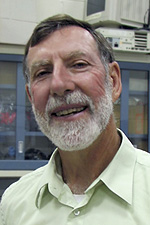Professor Arthur T. Johnson


 Arthur T. Johnson attended Cornell University for his undergraduate and graduate degrees. His Ph.D. was awarded in 1969, and he immediately began
serving as an officer in the U.S. Army, eventually serving in Viet Nam at the rank of captain. He was awarded the Army Commendation Medal and Bronze Star Medal. He joined the faculty of the University of Maryland in 1975, and was Professor from 1986 until 2009, when he became Professor Emeritus. He was cochairman of the committee to found the American Institute for Medical and Biological Engineering (AIMBE) from 1988 to 1992, and served as the Executive Director of AIMBE in 2004. He has been President of the Alliance for Engineering in Medicine and Biology (1984-1988), Institute for Biological Engineering (1998), and International Society for Respiratory Protection (2004-2006). He was the Secretary of the Biomedical Engineering Society from 2004 to 2009. He has been on the Board of Directors of the American Society for Agricultural and Biological Engineers (1995-1997). He is a Founding Fellow of the American Institute for Medical and Biological Engineering (1992), Life Fellow of the American Society for Engineering Education (1996), Life Fellow of the American Society for Agricultural and Biological Engineers (2002), Fellow of the American Industrial Hygiene Association (2005), Fellow of the Biomedical Engineering Society (2005), Fellow of the Institute for Biological Engineering (2009), and the Life Fellow of the Institute for Electrical and Electronics Engineers (2010). He is a member of the honor societies Phi Kappa Phi, Sigma Xi, Tau Beta Pi, and Alpha Epsilon. He has written three books: Biomechanics and Exercise Physiology: Quantitative Modeling, Biological Process Engineering, and Biology for Engineers. His research interests are human performance wearing respiratory protective masks, respiratory mechanics and measurement, and transport processes. He has been most recently active in teaching electronic design, transport processes, and engineering in biology courses, and working to continue development of the Airflow Perturbation Device as a noninvasive measurement of respiratory resistance.
Arthur T. Johnson attended Cornell University for his undergraduate and graduate degrees. His Ph.D. was awarded in 1969, and he immediately began
serving as an officer in the U.S. Army, eventually serving in Viet Nam at the rank of captain. He was awarded the Army Commendation Medal and Bronze Star Medal. He joined the faculty of the University of Maryland in 1975, and was Professor from 1986 until 2009, when he became Professor Emeritus. He was cochairman of the committee to found the American Institute for Medical and Biological Engineering (AIMBE) from 1988 to 1992, and served as the Executive Director of AIMBE in 2004. He has been President of the Alliance for Engineering in Medicine and Biology (1984-1988), Institute for Biological Engineering (1998), and International Society for Respiratory Protection (2004-2006). He was the Secretary of the Biomedical Engineering Society from 2004 to 2009. He has been on the Board of Directors of the American Society for Agricultural and Biological Engineers (1995-1997). He is a Founding Fellow of the American Institute for Medical and Biological Engineering (1992), Life Fellow of the American Society for Engineering Education (1996), Life Fellow of the American Society for Agricultural and Biological Engineers (2002), Fellow of the American Industrial Hygiene Association (2005), Fellow of the Biomedical Engineering Society (2005), Fellow of the Institute for Biological Engineering (2009), and the Life Fellow of the Institute for Electrical and Electronics Engineers (2010). He is a member of the honor societies Phi Kappa Phi, Sigma Xi, Tau Beta Pi, and Alpha Epsilon. He has written three books: Biomechanics and Exercise Physiology: Quantitative Modeling, Biological Process Engineering, and Biology for Engineers. His research interests are human performance wearing respiratory protective masks, respiratory mechanics and measurement, and transport processes. He has been most recently active in teaching electronic design, transport processes, and engineering in biology courses, and working to continue development of the Airflow Perturbation Device as a noninvasive measurement of respiratory resistance.